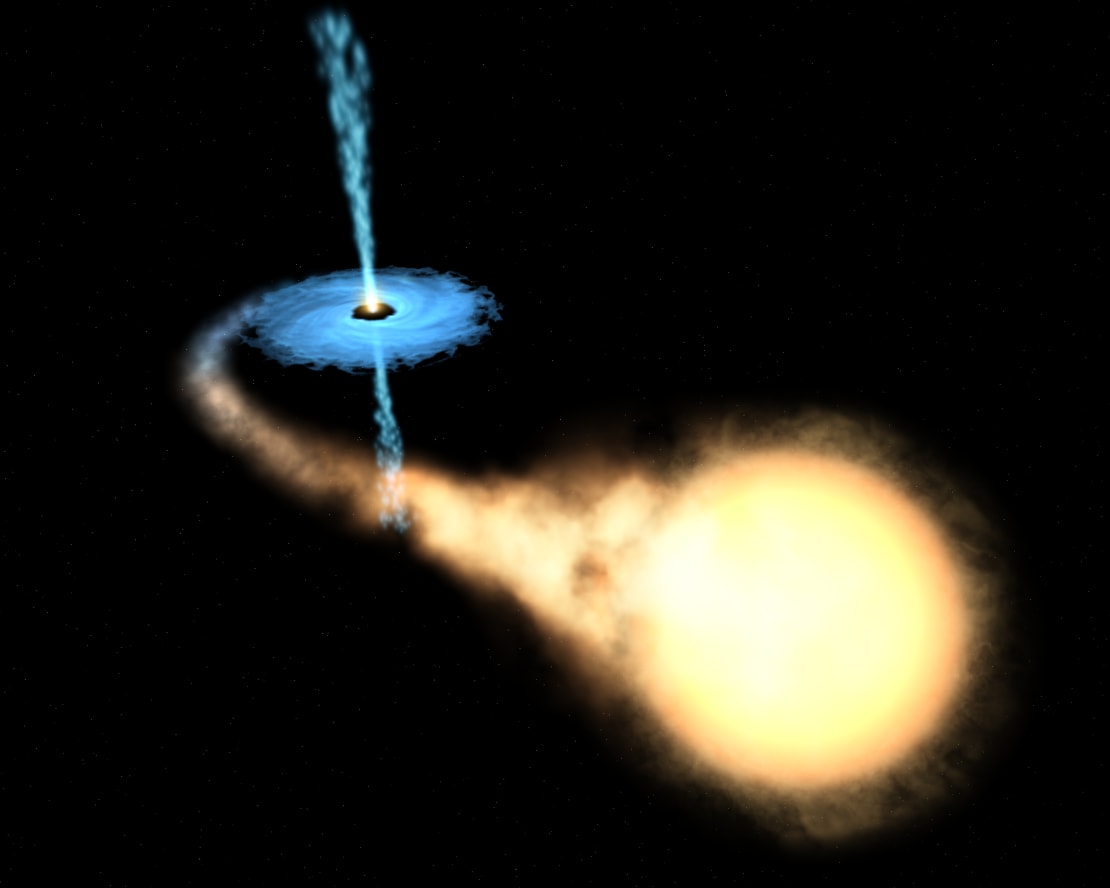X-ray binaries (XRB) consist of a compact object, such as a neutron star or a black hole, and a noncompact, companion star. When they are close enough, material is pulled off the star and drawn onto the compact companion, releasing intense X-rays that make them some of the most luminous sources in the sky.
Microquasars, a type of galactic X-ray binary that presents relativistic jets and creates an environment similar to active galactic nuclei (AGN), are promising sources of high-energy neutrinos within our galaxy, in the same way AGNs are the primary candidates for extragalactic sources.
This week, the IceCube Collaboration has presented the first comprehensive search for very high energy neutrino emission from galactic X-ray binary systems, which if found would also prove them to be cosmic-ray sources. The results, submitted this past week to The Astrophysical Journal Letters, do not show significant neutrino emission from these sources and are used to set upper limits on neutrino emission from X-ray binaries. The paper also discusses the discovery potential in the coming years, and it predicts that the improved sensitivity of IceCube-Gen2, a 10-times-larger, next-generation neutrino telescope that scientists plan to build around the current IceCube array, would provide a promising prospect to confirm or rule out these sources as neutrino and cosmic-ray accelerators.


In the Milky Way, X-ray binaries are primarily found along the galactic plane and near the galactic center. High- and low-mass X-ray binaries may accelerate cosmic rays to several PeV in or near the compact star, a region of the cosmic-ray spectrum that astrophysicists often call the knee. In these environments, neutrinos would be produced by the interaction of primary cosmic rays with radiation or gas in the jet of a microquasar, the stellar wind around them, or the atmosphere of the companion star.
We have detected cosmic rays up to 1021 eV at Earth. However, the question about what sources accelerate cosmic rays to these energies remains open. Hadronic cosmic rays interact with matter or light in the galaxy to produce high-energy pions that subsequently decay into gamma rays and neutrinos. And, while gamma rays could also be produced by accelerated leptons, high-energy neutrinos would point unequivocally to accelerators of cosmic rays.
The detection of a fairly isotropic distribution of high-energy neutrino events in IceCube suggests that the observable neutrino flux is dominated by extragalactic sources and that galactic sources may contribute up to 14% of the total neutrino flux above 1 TeV.
This study searches for neutrino emission from galactic X-ray binaries using 7.5 years of IceCube data and three separate analyses that cover a broader list of sources compared to previous studies:
- A search for periodic neutrino emission from 55 binaries in the Northern Hemisphere.
- A search for time-dependent neutrino emission associated with X-ray emission from 102 binaries across the entire sky.
- A time-integrated search for neutrino emission from four microquasars.

The data event selection focuses on high-quality throughgoing neutrino track events from anywhere in the sky and with an energy threshold near 100 GeV. These analyses were designed to identify neutrino emission from either flaring or periodic emissions observed in binary systems as well as for specific microquasars. Time-dependent searches can suppress more background than usual time-integrated methods and enhance the sensitivity of this search. “We use an improved temporal description to exploit the possibly time-dependent nature of the signal. In the optimal case, the sensitivity can be improved by a factor of a few,” explains Chris Tung, a recent PhD graduate at the Georgia Institute of Technology that co-led this study.
Since none of these searches showed a significant excess of neutrinos, researchers placed upper limits on the neutrino flux for each hypothesis. “We have also evaluated the improved sensitivity for IceCube-Gen2, and we are once more excited about the discovery potential of the planned extension of the IceCube Neutrino Observatory,” explains Qinrui Liu, who co-led this study as a PhD student at the University of Wisconsin–Madison and is currently a postdoc at Queen’s University.
This mixture of current data-based analyses and IceCube-Gen2’s long-term view is repeated again and again in the continuous search for cosmic-ray sources, and it establishes over and over the foundations on which the need for the next-generation neutrino telescope are based.
This is why the current study also estimates the sensitivity of the next-generation neutrino telescope, or IceCube-Gen2, and finds that the sensitivity to these sources will increase by a factor of 5, thus expanding the potential to verify whether X-ray binaries are indeed neutrino and cosmic-ray sources in our galaxy.
+info “Search for High-Energy Neutrino Emission from Galactic X-ray Binaries with IceCube,” IceCube Collaboration: M. G. Aartsen et al., The Astrophysical Journal Letters 930 (2022) 2, L24, iopscience.iop.org, arxiv.org/abs/2202.11722